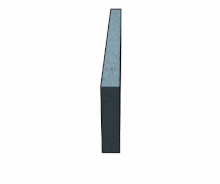Spallation
This article needs additional citations for verification. (December 2015) |

| Nuclear physics |
|---|
 |
Spallation is a process in which fragments of material (
atomic weight. In industrial processes and bioprocessing the loss of tubing material due to the repeated flexing of the tubing within a peristaltic pump
is termed spallation.
In solid mechanics
Spallation can occur when a tensile stress wave propagates through a material and can be observed in flat plate impact tests. It is caused by an internal
tensile strength of materials. A fragment or multiple fragments will be created on the free end of the plate. This fragment known as "spall" acts as a secondary projectile with velocities that can be as high as one third of the stress wave speed on the material. This type of failure is typically an effect of high explosive squash head (HESH
) charges.
Laser spallation
Laser induced spallation is a recent experimental technique developed to understand the
thin films (1 micrometre in thickness or less). It is also possible to mode convert a longitudinal stress wave into a shear stress
using a pulse shaping prism and achieve shear spallation.
Nuclear spallation
Nuclear spallation from the impact of cosmic rays occurs naturally in
, formed by spallation of terrestrial elements under cosmic ray bombardment, have been detected on Earth.Nuclear spallation is one of the processes by which a
energy efficiency
of the processes involved, net usable energy could be generated while being able to use actinides unsuitable for use in conventional reactors as "fuel".
Production of neutrons at a spallation neutron source
| Science with neutrons |
|---|
 |
| Foundations |
|
| Neutron scattering |
|
| Other applications |
|
| Infrastructure |
|
|
Neutron facilities |
Generally the production of neutrons at a spallation source begins with a high-powered proton
moderators filled with liquid hydrogen or liquid methane
to the energies that are needed for the scattering instruments. Whilst protons can be focused since they have charge, chargeless neutrons cannot be, so in this arrangement the instruments are arranged around the moderators.
X-rays
.
See also
- Energy amplifier
- Subcritical reactor (accelerator-driven system)
- Sputtering (phenomenon in which microscopic particles of a solid material are ejected from its surface)
Spallation facilities
- European Spallation Source, under construction, Sweden
- ISIS neutron source, Harwell, UK
- J-PARC
- LANSCELos Alamos
- PSI Spallation Neutron Source (SINQ), Switzerland
- Spallation Neutron Source Oak Ridge, USA
- China Spallation Neutron Source
References
- ^ "Spallation Target | Paul Scherrer Institut (PSI)". Psi.ch. Retrieved 2015-12-12.
- S2CID 121427439.
- S2CID 28796927. Archived from the original(PDF) on 2019-03-03. Retrieved October 20, 2019.
- S2CID 42506679.
External links
- IAEA database of spallation neutron sources in the Accelerator Knowledge Portal
- Description of ISIS accelerator etc.
- Spallation Neutron Source technical background.
- How spallation works at the ISIS neutron and muon source
